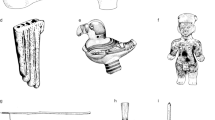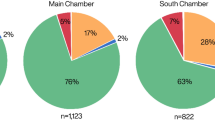Abstract
Considerable debate surrounds claims for early evidence of music in the archaeological record1,2,3,4,5.Researchers universally accept the existence of complex musical instruments as an indication of fully modern behaviour and advanced symbolic communication1but, owing to the scarcity of finds, the archaeological record of the evolution and spread of music remains incomplete. Although arguments have been made for Neanderthal musical traditions and the presence of musical instruments in Middle Palaeolithic assemblages, concrete evidence to support these claims is lacking1,2,3,4.Here we report the discovery of bone and ivory flutes from the early Aurignacian period of southwestern Germany. These finds demonstrate the presence of a well-established musical tradition at the time when modern humans colonized Europe, more than 35,000 calendar years ago. Other than the caves of the Swabian Jura, the earliest secure archaeological evidence for music comes from sites in France and Austria and post-date 30,000 years ago6,7,8.
This is a preview of subscription content,access via your institution
Access options
Subscribe to this journal
Receive 51 print issues and online access
185,98 € per year
only 3,65 € per issue
Buy this article
- Purchase on SpringerLink
- Instant access to full article PDF
Prices may be subject to local taxes which are calculated during checkout



Similar content being viewed by others
References
d’Errico, F. et al. Archaeological evidence for the emergence of language, symbolism, and music—an alternative multidisciplinary perspective.J. World Prehist.17,1–70 (2003)
Turk, I.Mousterian “Bone Flute” and Other Finds from Divje Babe I Cave Site in Slovenia(Znanstvenoraziskovalni Center SAZU, 1997)
Albrecht, G., Holdermann, C.-S., Kerig, T., Lechterbech, J. & Serangeli, J. „Flöten” aus Bärenknochen – die frühsten Musikinstrumente?Archäol. Korrespondenzblatt28,1–19 (1998)
d’Errico, F., Villa, P., Pinto, A. & Idarraga, R. A Middle Paleolithic origin of music? Using cave-bear bone accumulations to assess the Divje Babe I bone ‘flute’.Antiquity72,65–79 (1998)
Mithen, S.The Singing Neanderthals(Weidenfield & Nicolson, 2005)
Buisson, D. Les flûtes paléolithiques d’Isturitz (Pyrénées Atlantiques).Bull. Soc. Préhist. Française87,420–433 (1990)
Lawson, G. & d’Errico, F. inStudien zur Musikarchäologie III(eds Hickmann, E., Kilmer, A. D. & Eichmann, R.) 119–142 (Orient-Archäologie 10, Maria Leihdorf, 2002)
Einwögerer, T. & Bernadette Käfer, B. Eine jungpaläolithische Knochenflöte aus der Station Grubgraben bei Kammern, Niederösterreich.Archäol. Korrespondenzblatt28,21–30 (1998)
Conard, N. J. & Bolus, M. Radiocarbon dating the appearance of modern humans and the timing of cultural innovations in Europe: new results and new challenges.J. Hum. Evol.44,331–371 (2003)
Hahn, J. & Münzel, S. Knochenflöten aus dem Aurignacien des Geißenklösterle bei Blaubeuren, Alb-Donau-Kreis.Fundber. Baden-Württemb.20,1–12 (1995)
Münzel, S., Seeberger, F. & Hein, W. inStudien zur Musikarchäologie III(eds Hickmann, E., Kilmer, A. D. & Eichmann, R.) 107–118 (Orient-Archäologie 10, Maria Leihdorf, 2002)
Hein, W. & Hahn, J. inExperimentelle Archäologie in Deutschland: Bilanz 1997(ed. Fansa, M.) 65–73 (Isensee, 1998)
Seeberger, F.Klangwelten der Altsteinzeit[audio CD] (Urgeschichtliches Museum Blaubeuren, 2004)
Tarasov, N. Die älteste Flöte der Welt.Windkanal1,6–11 (2005)
Conard, N. J. et al. Eine Mammutelfenbeinfköte aus dem Aurignacien des Geißenklösterle.Archäol. Korrespondenzblatt34,447–462 (2004)
Conard, N. J. & Malina, M. Schmuck und vielleicht auch Musik am Vogelherd bei Niederstotzingen-Stetten ob Lontal, Kreis Heidenheim.Archäol. Ausgr. Baden-Württemb.21–25 (2006)
Richter, D., Waiblinger, J., Rink, W. J. & Wagner, G. A. Thermoluminescence, electron spin resonance and14C-dating of the late middle and early upper Palaeolithic site of Geißenklösterle cave in southern Germany.J. Archaeol. Sci.27,71–89 (2000)
Conard, N. J. & Bolus, M. Radiocarbon dating the late Middle Paleolithic and the Aurignacian of the Swabian Jura.J. Hum. Evol.55,886–897 (2008)
Zilhão, J. & d’Errico, F. inThe Chronology of the Aurignacian and of the Transitional Technocomplexes: Dating, Stratigraphies, Cultural Implications(eds Zilhão, J. & d’Errico, F.) 313–349 (Proc. Symp. Trabalhos de Arqueologia 33, Instituto Português de Arqueologia, 2003)
Jöris, O. & Street, M. At the end of the14C time scale – the middle to upper Paleolithic record of western Eurasia.J. Hum. Evol.55,782–802 (2008)
Conard, N. J. A female figurine from the basal Aurignacian of Hohle Fels Cave in southwestern Germany.Nature459,248–252 (2009)
Brock, F., Bronk Ramsey, C. & Higham, T. Quality assurance of ultrafiltered bone dating.Radiocarbon49,187–192 (2007)
Hüls, M. C., Grootes, P. M. & Nadeau, M.-J. How clean is ultrafiltration cleaning of bone collagen?Radiocarbon49,193–200 (2007)
Weninger, B. & Jöris, O. A14C age calibration curve for the last 60 ka: the Greenland-Hulu U/Th timescale and its impact on understanding the Middle to Upper Paleolithic transition in Western Eurasia.J. Hum. Evol.55,772–781 (2008)
Conard, N. J. & Bolus, M. inTowards a Definition of the Aurignacian(eds Bar-Yosef, O. & Zilhão, J.) 211–239 (Proc. Symp. Trabalhos de Arqueologia 45, Instituto Português de Arqueologia/American School of Prehistoric Research, 2006)
Bolus, M. & Conard, N. J. What can we say about the spatial-temporal distribution of early Aurignacian innovations?Eurasian Prehist.5,19–29 (2009)
Conard, N. J. et al. inWhen Neanderthals and Modern Humans Met(ed. Conard, N. J.) 305–341 (Kerns, 2006)
Acknowledgements
Many of our colleagues, including S. Bailey, H. Bocherens, M. Bolus, K. Deckers, S. Feine, H. Floss, P. Goldberg, P. Grootes, W. Hein, T. Higham, M. Hofreiter, M. Kucera, L. Moreau, L. Niven, D. Richter, S. Riehl, F. H. Smith, H.-P. Uerpmann and S. Wolf, contributed to this research. We are particularly indebted to C. E. Miller for discussions on stratigraphy, to B. Ligouis for his microscopic images of flute 1 from Hohle Fels and to P. Krönneck for identification of bird bones. This research was supported by the Deutsche Forschungsgemeinschaft, the University of Tübingen, the Heidelberger Akademie der Wissenschaften, the Landesamt für Denkmalpflege Baden-Württemberg, the Alb-Donau-Kreis, Heidelberg Cement, the Museumsgesellschaft Schelklingen and the Gesellschaft für Urgeschichte.
Author ContributionsN.J.C. directs the project and wrote the paper. M.M. coordinates the excavation and laboratory work at Hohle Fels. S.C.M. conducts faunal analysis at Hohle Fels.
Author information
Authors and Affiliations
Corresponding author
Rights and permissions
About this article
Cite this article
Conard, N., Malina, M. & Münzel, S. New flutes document the earliest musical tradition in southwestern Germany. Nature460,737–740 (2009). https://doi.org/10.1038/nature08169
Received:
Accepted:
Published:
Issue Date:
DOI:https://doi.org/10.1038/nature08169
This article is cited by
-
Bone aerophones from Eynan-Mallaha (Israel) indicate imitation of raptor calls by the last hunter-gatherers in the Levant
Scientific Reports(2023)
-
Biological principles for music and mental health
Translational Psychiatry(2023)
-
How being perceived to be an artist boosts feelings of attraction in others
Scientific Reports(2023)
-
Universality, domain-specificity and development of psychological responses to music
Nature Reviews Psychology(2023)
-
Revaluation of the Portable Art of Northern Iberia: a Magdalenian Decorated Bone Tube from Torre (Basque Country, Spain)
Journal of Paleolithic Archaeology(2023)
Comments
By submitting a comment you agree to abide by ourTermsandCommunity Guidelines.If you find something abusive or that does not comply with our terms or guidelines please flag it as inappropriate.



